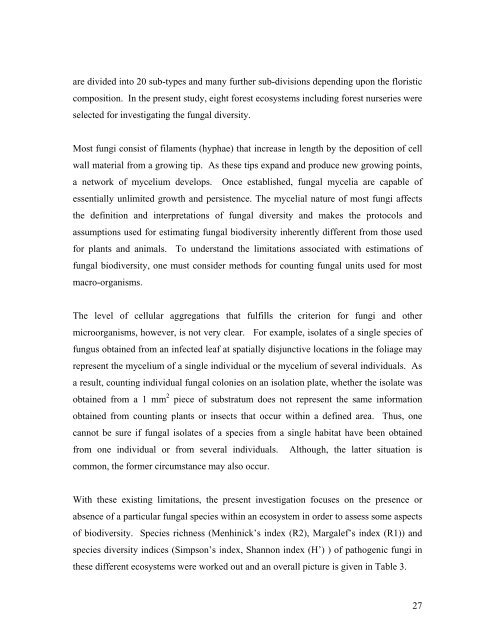Biodiversity of Plant Pathogenic Fungi - Kerala Forest Research ...
Biodiversity of Plant Pathogenic Fungi - Kerala Forest Research ...
Biodiversity of Plant Pathogenic Fungi - Kerala Forest Research ...
You also want an ePaper? Increase the reach of your titles
YUMPU automatically turns print PDFs into web optimized ePapers that Google loves.
are divided into 20 sub-types and many further sub-divisions depending upon the floristic<br />
composition. In the present study, eight forest ecosystems including forest nurseries were<br />
selected for investigating the fungal diversity.<br />
Most fungi consist <strong>of</strong> filaments (hyphae) that increase in length by the deposition <strong>of</strong> cell<br />
wall material from a growing tip. As these tips expand and produce new growing points,<br />
a network <strong>of</strong> mycelium develops. Once established, fungal mycelia are capable <strong>of</strong><br />
essentially unlimited growth and persistence. The mycelial nature <strong>of</strong> most fungi affects<br />
the definition and interpretations <strong>of</strong> fungal diversity and makes the protocols and<br />
assumptions used for estimating fungal biodiversity inherently different from those used<br />
for plants and animals. To understand the limitations associated with estimations <strong>of</strong><br />
fungal biodiversity, one must consider methods for counting fungal units used for most<br />
macro-organisms.<br />
The level <strong>of</strong> cellular aggregations that fulfills the criterion for fungi and other<br />
microorganisms, however, is not very clear. For example, isolates <strong>of</strong> a single species <strong>of</strong><br />
fungus obtained from an infected leaf at spatially disjunctive locations in the foliage may<br />
represent the mycelium <strong>of</strong> a single individual or the mycelium <strong>of</strong> several individuals. As<br />
a result, counting individual fungal colonies on an isolation plate, whether the isolate was<br />
obtained from a 1 mm 2 piece <strong>of</strong> substratum does not represent the same information<br />
obtained from counting plants or insects that occur within a defined area. Thus, one<br />
cannot be sure if fungal isolates <strong>of</strong> a species from a single habitat have been obtained<br />
from one individual or from several individuals. Although, the latter situation is<br />
common, the former circumstance may also occur.<br />
With these existing limitations, the present investigation focuses on the presence or<br />
absence <strong>of</strong> a particular fungal species within an ecosystem in order to assess some aspects<br />
<strong>of</strong> biodiversity. Species richness (Menhinick’s index (R2), Margalef’s index (R1)) and<br />
species diversity indices (Simpson’s index, Shannon index (H’) ) <strong>of</strong> pathogenic fungi in<br />
these different ecosystems were worked out and an overall picture is given in Table 3.<br />
27

















